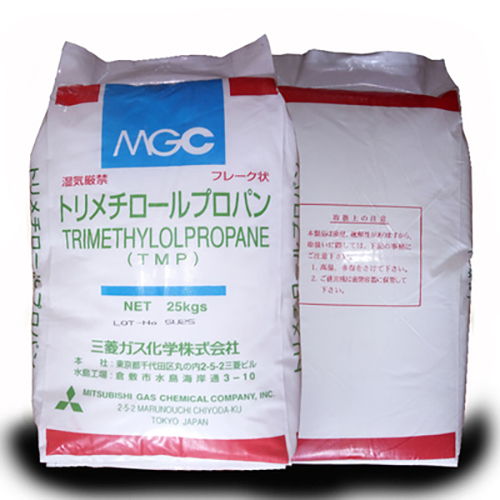Application of trimethylolpropane
Background
Trimethylolpropane (TMP for short), white flaky crystal[1]. Soluble in water, low-carbon alcohol, glycerol, N,N-dimethylformamide, partially soluble in acetone, ethyl acetate, slightly soluble in carbon tetrachloride, ether and chloroform. Mainly used in alkyd resins, polyurethanes, unsaturated resins, polyester resins, coatings and other fields. It can also be used in the synthesis of aviation lubricants, printing inks, etc., and can also be used as textile auxiliaries and heat stabilizers for polyvinyl chloride resins. Trimethylolpropane is easily soluble in water, lower alcohols, glycerol, N,N-dimethylformamide, partially soluble in acetone, ethyl acetate, slightly soluble in carbon tetrachloride, ether and chloroform, insoluble in fat Hydrocarbons, aromatic hydrocarbons and chlorinated hydrocarbons. Its hygroscopicity is about 50 of that of glycerin.
Synthesis
The condensation reaction of n-butyraldehyde and formaldehyde is carried out under alkaline conditions. The reaction solution is concentrated and demineralized, then decolorized by ion exchange resin, purified, and finally evaporated, cooled and rolled by a thin film evaporator to obtain the finished product.
Application
Trimethylolpropane is an important fine chemical product, and it is a commonly used chain extender in the resin industry. It has a low melting point and has three methylol groups in its molecular structure. It can react with organic acids to form monoesters or polyesters, react with aldehydes and ketones to form acetals and ketals, and react with diisocyanates to form carbamates.
Trimethylolpropane is mainly used in alkyd resins, polyurethanes, unsaturated resins, polyester resins, coatings and other fields, and can also be used in the synthesis of aviation lubricants, plasticizers, surfactants, wetting agents, explosives, printing inks It can also be used as a textile auxiliary and a heat stabilizer for polyvinyl chloride resin.

Picture 1 A bag of DMP
Emergency treatment
Isolate the leaked contaminated area and restrict access. Cut off the source of ignition. It is recommended that emergency personnel wear dust masks (full face masks) and general work clothes. Mix with sand, dry lime or soda ash. Collect in a dry, clean, covered container and transfer to a safe place. If there is a large amount of leakage, collect it for recycling or transport it to a waste disposal site for disposal.
Storage and transportation characteristics
Handling precautions for trimethylolpropane. Closed operation and enhanced ventilation. Operators must undergo special training and strictly abide by operating procedures. It is recommended that operators wear self-priming filter dust masks. Keep away from fire and heat sources, and smoking is strictly prohibited in the workplace. Use explosion-proof ventilation systems and equipment. Avoid contact of trimethylolpropane with oxidants and acids. When handling trimethylolpropane, light loading and unloading to prevent package damage. Equipped with the corresponding variety and quantity of fire fighting equipment and leakage emergency treatment equipment. Empty containers of trimethylolpropane may remain hazardous.
Storage precautions for trimethylolpropane. Trimethylolpropane should be stored in a cool, ventilated warehouse. Keep away from fire and heat sources. It should be stored separately from oxidants and acids, and should not be mixed. Equipped with the appropriate variety and quantity of fire equipment. Trimethylolpropane storage areas should be provided with suitable materials to contain spills.
When shipping trimethylolpropane, the packaging should be complete and the loading should be secure. During transportation, make sure that the container does not leak, collapse, fall or be damaged. It is strictly forbidden to mix and transport with oxidants, acids, etc. During transportation, it should be protected from exposure to sunlight, rain, and high temperature.
Market prospect broadcast
In my country, TMP is mainly used as a raw material for the synthesis of high-grade alkyd resin paint, and its consumption accounts for about 85% of the total domestic consumption of TMP. In this application field, TMP is mainly used for the production of high-grade paints for automobiles. Another important consumption area of TMP in my country is as a plasticizer. In order to meet the domestic demand for TMP, many manufacturers want to build or expand production facilities. The market outlook is good.
Reference
1 Trimethylolpropane. Chemical Dictionary, 2015
Related articles And Qustion
See also
Lastest Price from Trimethylolpropane manufacturers

US $0.00/KG2025-04-21
- CAS:
- 77-99-6
- Min. Order:
- 1KG
- Purity:
- 98%min
- Supply Ability:
- 30tons/month

US $0.00/KG2025-04-21
- CAS:
- 77-99-6
- Min. Order:
- 1KG
- Purity:
- 99%
- Supply Ability:
- 10 mt



